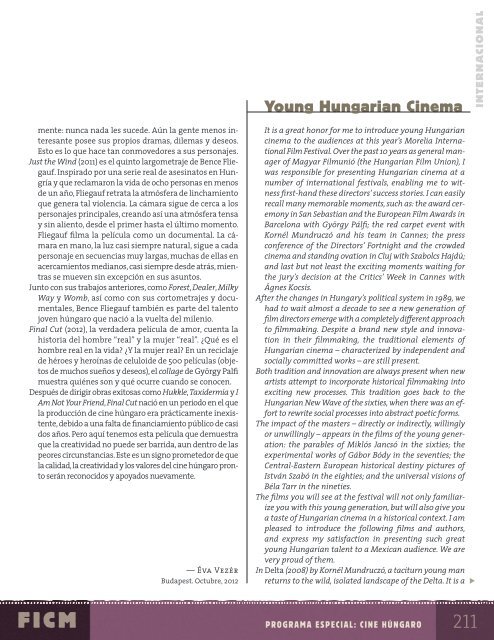catalogo-2012
catalogo-2012
catalogo-2012
Create successful ePaper yourself
Turn your PDF publications into a flip-book with our unique Google optimized e-Paper software.
mente: nunca nada les sucede. Aún la gente menos interesante<br />
posee sus propios dramas, dilemas y deseos.<br />
Esto es lo que hace tan conmovedores a sus personajes.<br />
Just the Wind (2011) es el quinto largometraje de Bence Fliegauf.<br />
Inspirado por una serie real de asesinatos en Hungría<br />
y que reclamaron la vida de ocho personas en menos<br />
de un año, Fliegauf retrata la atmósfera de linchamiento<br />
que genera tal violencia. La cámara sigue de cerca a los<br />
personajes principales, creando así una atmósfera tensa<br />
y sin aliento, desde el primer hasta el último momento.<br />
Fliegauf filma la película como un documental. La cámara<br />
en mano, la luz casi siempre natural, sigue a cada<br />
personaje en secuencias muy largas, muchas de ellas en<br />
acercamientos medianos, casi siempre desde atrás, mientras<br />
se mueven sin excepción en sus asuntos.<br />
Junto con sus trabajos anteriores, como Forest, Dealer, Milky<br />
Way y Womb, así como con sus cortometrajes y documentales,<br />
Bence Fliegauf también es parte del talento<br />
joven húngaro que nació a la vuelta del milenio.<br />
Final Cut (<strong>2012</strong>), la verdadera película de amor, cuenta la<br />
historia del hombre “real” y la mujer “real”. ¿Qué es el<br />
hombre real en la vida? ¿Y la mujer real? En un reciclaje<br />
de héroes y heroínas de celuloide de 500 películas (objetos<br />
de muchos sueños y deseos), el collage de György Palfi<br />
muestra quiénes son y qué ocurre cuando se conocen.<br />
Después de dirigir obras exitosas como Hukkle, Taxidermia y I<br />
Am Not Your Friend, Final Cut nació en un periodo en el que<br />
la producción de cine húngaro era prácticamente inexistente,<br />
debido a una falta de financiamiento público de casi<br />
dos años. Pero aquí tenemos esta película que demuestra<br />
que la creatividad no puede ser barrida, aun dentro de las<br />
peores circunstancias. Este es un signo prometedor de que<br />
la calidad, la creatividad y los valores del cine húngaro pronto<br />
serán reconocidos y apoyados nuevamente.<br />
— Éva Vezér<br />
Budapest. Octubre, <strong>2012</strong><br />
Youn g Hungarian Cinema<br />
It is a great honor for me to introduce young Hungarian<br />
cinema to the audiences at this year’s Morelia International<br />
Film Festival. Over the past 10 years as general manager<br />
of Magyar Filmunió (the Hungarian Film Union), I<br />
was responsible for presenting Hungarian cinema at a<br />
number of international festivals, enabling me to witness<br />
first-hand these directors’ success stories. I can easily<br />
recall many memorable moments, such as: the award ceremony<br />
in San Sebastian and the European Film Awards in<br />
Barcelona with György Pálfi; the red carpet event with<br />
Kornél Mundruczó and his team in Cannes; the press<br />
conference of the Directors’ Fortnight and the crowded<br />
cinema and standing ovation in Cluj with Szabolcs Hajdú;<br />
and last but not least the exciting moments waiting for<br />
the jury’s decision at the Critics’ Week in Cannes with<br />
Ágnes Kocsis.<br />
After the changes in Hungary’s political system in 1989, we<br />
had to wait almost a decade to see a new generation of<br />
film directors emerge with a completely different approach<br />
to filmmaking. Despite a brand new style and innovation<br />
in their filmmaking, the traditional elements of<br />
Hungarian cinema – characterized by independent and<br />
socially committed works – are still present.<br />
Both tradition and innovation are always present when new<br />
artists attempt to incorporate historical filmmaking into<br />
exciting new processes. This tradition goes back to the<br />
Hungarian New Wave of the sixties, when there was an effort<br />
to rewrite social processes into abstract poetic forms.<br />
The impact of the masters – directly or indirectly, willingly<br />
or unwillingly – appears in the films of the young generation:<br />
the parables of Miklós Jancsó in the sixties; the<br />
experimental works of Gábor Bódy in the seventies; the<br />
Central-Eastern European historical destiny pictures of<br />
István Szabó in the eighties; and the universal visions of<br />
Béla Tarr in the nineties.<br />
The films you will see at the festival will not only familiarize<br />
you with this young generation, but will also give you<br />
a taste of Hungarian cinema in a historical context. I am<br />
pleased to introduce the following films and authors,<br />
and express my satisfaction in presenting such great<br />
young Hungarian talent to a Mexican audience. We are<br />
very proud of them.<br />
In Delta (2008) by Kornél Mundruczó, a taciturn young man<br />
returns to the wild, isolated landscape of the Delta. It is a u<br />
FICM PROGRAMA ESPECIAL: CINE HÚNGARO<br />
INTERNACIONAL<br />
211


